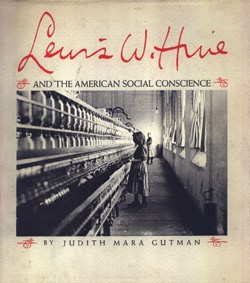| by Maurizio Berlincioni Born in Oshkosh, Wisconsin, Hine spent his early youth working in a factory ( a twist of fate that enabled him to experience at first hand the world he would later photograph). He attended to his advantage the universities of Chicago and New York and graduated in Sociology.
Commencing his career as a teacher in a New York school, he decided to make use of photography in order to dramatize and render more efficient his teaching. However he was soon to leave this job at least on a formal level (since essentially he always remained in the true sense of the word a teacher) in order to give himself up completely to photography.
I don't believe it would be an exaggeration to herald him as a crusader in the struggle against the tragedy of social exploitation and injustice, compelled always as he was by the desire to share his vision with others, to the more fortunate, to those who, immersed in the apathy and greed of their well-being, thwarted the expectations with which the new world teased millions of human beings lived in hope of better living conditions.
It's exactly this world of broken promises and thwarted expectation that Hine tried to present documenting it in all its crudity and squalor, though always with an affectionate eye for his subjects, an ability for empathy owing not only to his cultural education but also to his artist's sensibility. | One of the books with the photographs of Lewis W. Hine | 
|
In the first decade of the century Hine concentrated his attention on the immigrants that landed in their thousands on Ellis Island. He followed them to their squalid dwellings, entered the miserable places where they worked, cast a sympathetic eye over the games their children played amidst the human rubbish and wreckage that littered the streets of New York's underworld.
Perfectly aware of the subjective value of his photographs, he believed, with reason, that they carried an explosive charge, capable of arousing indignation and a desire for change in a society founded almost exclusively on the exploitation of the most humble and destitute. Sturdy as a result of his cultural education, he moved freely in this difficult world of discrimination and his images are never sentimental.
Without question one can refer to his work as the first example of the photo story: he himself defined his images as photo-interpretation and he published them as human documents. The pictures of children, inside and outside the factories, carried out on behalf of the National Child Labour Committee, the very images that succeeded in attracting the attention of Americans to the exploitation of child labour and that were instrumental in the proposition of certain fundamental child-protection laws, are very often of a staggering formal beauty, an aspect that, never being an end in itself, does not belittle their informative power and social implications.
On the other hand the gaze of Hine never exclusively turned towards the negative aspects of reality that surrounded him. Born in the countryside of Wisconsin, he always carried within himself, despite living in a large metropolis, that sense of wonder and respect for the grandeur of nature which characterises those whose roots lie in a rural environment.
Lewis W. Hine set great store by what he considered a primary duty - that of showing to his fellow citizens how often the prospect of new opportunities heralded by technological progress are tragically and brutally betrayed. Many pictures, taken in 1916, document poignantly the activities of the American Red Cross in a Europe devastated by the First World War.
In 1932 a book entitled Men at Work was published, among whose photos those taken by Hine among the men who participated in the construction of the Empire State Building, at that time the tallest building in the world, stand out for their beauty and originality . This work was later complemented by his next book, Women at Work.
Considered almost a genius in his lifetime, Hine had the misfortune to end his days poor and virtually overlooked by a society that had neither the time nor the inclination to dwell on his cherished themes like social commitment and solidarity.
Only in recent times, times in which unfortunately these themes have tragically returngd to haunt us, has the work of Hine been rediscovered and re-evaluated in all its importance.
(© 1997 M.Berlincioni)
Bibliography |